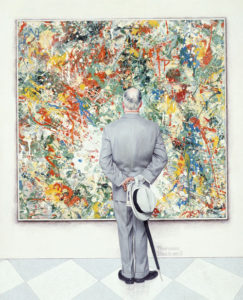Every Sunday morning after attending mass, my grandmother had my siblings and I over for some tea and breakfast. Hung inside of her kitchen was a calendar designed by Norman Rockwell. Art tended to catch my attention as a child, and still does today. Impatiently, I’d flip through the calendar regardless of the current month to preview every illustration. Rockwell worked with such detail. Every line on the paper seemed to have a purpose. People’s emotions were depicted so realistically. I think that it was that realism that me admire Rockwell as an artist.
In middle school, I was shown a short film in art class, which introduced me to the modern artist, Jackson Pollock. Artistically, Pollock seemed to stand as far away from Rockwell as one could imagine. While Rockwell focused on detail, Pollock splatter painted onto canvases. He used an array of colors and his pieces varied in size. It is said that some of his pieces accidentally incorporated flies and other insects. To a middle school student who had cherished Rockwell’s detail-oriented work, Pollock’s art was something unique and new. His abstraction said spoke to me, and from what it seemed, multiple others. In fact, Pollock’s art seemed to challenge Rockwell.
In high school, I came across the following photo:
I had struck gold.
This painting, The Connoisseur, was published in The Saturday Evening Post, a newspaper which frequently published Rockwell’s art, in 1961. Norman Rockwell created The Connoisseur in response to the modern art movement. Many believe that this was Rockwell’s, “acknowledgement of appreciation for the genre.” Personally, I believe that the most fascinating feature of this piece is the placement of the man, or as the title hints, the connoisseur. In the dictionary, a connoisseur is defined as an, “expert judge in matters of taste.” This title outwardly states that the man in this picture is judging Pollock’s work. However, no one can see the man’s reaction to Pollock’s work in the picture. This piece of art seems to purposefully spark some curiosity. Is the man supposed to represent the everyday American looking at Rockwell’s work? Is the man supposed to represent Rockwell?
Recently in class, we discussed the term voyeurism. The Merriam-Webster dictionary describes this as, “the practice of taking pleasure in observing something private, sordid, or scandalous.” In more simplistic terms, voyeurism involves a person watching another individual who is unaware that they are being watched.
The term specifically came up as we discussed the character Vlepo, from Frenzy and as we watched the movie The Defiant Ones. In Frenzy, the character Vlepo was able to travel and see other people’s private conversations and actions as Dionysus’s right-hand man. At one point in the novel Vlepo states, “I left off studying the eyes of Agave, the hard, pressing, omophagic eyes, and looked at Sibyl, so beautiful and soft, her mouth, however, filled with the same blood as her companion’s.” Here, Vlepo is clearly committing voyeurism against Agave and Sibyl. He watches the two ladies who are unaware of Vlepo’s presence. Additionally, Professor McCoy pointed out that as viewers of The Defiant Ones, we were committing voyeurism. This is a valid point, as we watched characters who were unaware that they were being watched.
In a way, looking at the painting, The Connoisseur, is a form of voyeurism. We, as viewers of the painting, are looking at the man with his face turned the other direction. In fact, many people dig deeper and curiously wonder what his facial expression is, what his thoughts consist of, or what he looks like. By looking at this man who does not know that he is being watched we are committing voyeurism.
At a deeper level, Rockwell might even be admitting his voyeuristic nature and alluding to his curiosity an satisfaction of Pollock as an artist. Although it may not be true, many people assume that the man in the picture represents Norman Rockwell. Additionally, the painting on the wall may very well represent Jackson Pollock as a person. I think that The Connoisseur is a message from Rockwell to Pollock, conveying the message that he is watching Pollock’s work and critiquing it. It’s as if Rockwell has been privately observing Pollock’s work, and through this painting, publicly admits that he has been.
While the term voyeurism holds negative connotation and is often looked down upon, people commit voyeurism all the time. The simple acts of people watching and watching a movie are minor acts of voyeurism. In fact, even when we look at people in paintings, we are practicing voyeurism.

